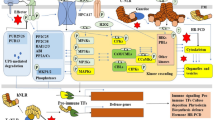Abstract
Using indirect immunofluorescence with hybridoma supernatants on intact epidermal peels of the argenteum mutant of Pisum sativum L. and Commelina communis L. as a secondary screen, three monoclonal antibodies have been derived and characterized. The distribution of the antibody binding to the epidermal strips indicated restricted occurrence of the corresponding epitopes in the cell wall material exposed on the inner face of the epidermal tissue. The monoclonal antibody JIM18 bound to the lining of the stomatal pore in pea and the exposed surface of the epidermal tissue corresponding to the stomatal complexes, including the subsidiary cells, in C. communis. JIM19 and JIM20 bound to the exposed surface of non-guard-cell epidermal cells in pea and the exposed surface of cells other than the guard cells and subsidiary cells in C. communis. However, the JIM19 epitope was revealed in the wall in the regions of the stomatal complexes subsequent to a short treatment with wall-digesting enzymes. This indicates regulation of epitope occurrence within cell walls in relation to adhered and un-adhered plant cell surfaces and also in relation to wall architecture in the complex epidermal tissues. The JIM18, JIM19 and JIM20 epitopes/antigens have distinct biochemical properties. JIM18 recognized a low-molecular-weight component which was present at the dye-front of a sodium dodecyl sulfate-polyacrylamide gel electrophoresis gel and which was soluble in chloroform, was periodate-sensitive and is likely to be a glycolipid. JIM19 and JIM20 recognized epitopes of hydroxyproline rich glycoproteins known to be regulated in relation to developmental anatomy. JIM19, in addition, as demonstrated in the companion report (Wang et al. 1995, 196, 271–276), has biological activity in relation to abscisic acid (ABA) interaction with ABA-sensitive barley aleurone cells.
Similar content being viewed by others
Abbreviations
- ELISA:
-
enzyme-linked immunosorbent assay
- HRGP:
-
hydroxyproline-rich glycoprotein
References
Bazin, H. (1982) Production of rat monoclonal antibodies with the LOU rat non-secreting IR983F myeloma cell line. Prot. Biol. Fluids 29, 615–618
Donovan, N., Peart, J., Roberts, K., Knox, J.P., Wang, M., Neill, S.J. (1993) Production and characterization of monoclonal antibodies against guard cell protoplasts of Pisum sativum. J. Exp. Bot. 44, Suppl., 4
Galfrè G., Milstein, C. (1981) Preparation of monoclonal antibodies: strategies and procedures. Methods Enzymol. 73, 3–46
Key, G., Weiler, E.W. (1988) Monoclonal antibodies identify common and differentiationspecific antigens on the plasma membrane of guard cells of Vicia faba L. Planta 176, 472–481
Knox, J.P. (1992) Molecular probes for the plant cell surface. Protoplasma 167, 1–9
Knox, J.P. (1993) The role of cell surface glycoproteins in differentiation and morphogenesis. In: Post-translational modification in plants (Society for Experimental Biology Seminar Series 53), pp. 267–283, Battey, N.H., Dickinson, H.G., Hetherington, A.M., eds. Cambridge University Press
Knox, J.P., Day, S., Roberts, K. (1989) A set of cell surface glycoproteins forms an early marker of cell position, but not cell type, in the root apical meristem of Daucus carota L. Development 106, 47–56
Knox, J.P., Linstead, P.J., Peart, J., Cooper, C., Roberts, K. (1991) Developmentally regulated epitopes of cell surface arabinogalactan proteins and their relation to root tissue pattern formation. Plant J. 1, 317–326
Roberts, K. (1990) Structures at the plant cell surface. Curr. Opin. Cell Biol. 2, 920–928
Smallwood, M., Beven, A., Donovan, N., Neill, S.J., Peart, J., Roberts, K., Knox, J.P. (1994) Localization of cell wall proteins in relation to the developmental anatomy of the carrot root apex. Plant J. 5, 237–246
Smallwood, M., Martin, H., Knox, J.P. (1995) An epitope of rice threonine- and hydroxyproline-rich glycoprotein is common to cell wall and hydrophobic plasma-membrane glycoproteins. Planta 196, in press
Smith, S., Weyers, J.D.B. (1990) Purified guard-cell protoplasts from the leaf epidermis of the argenteum mutant of Pisum sativum. Pisum Newslett. 22, 55–58
Wang, M., Heimovaara-Dijkstra, S., Van der Meulen, R.M., Knox, J.P., Neill, S.J. (1995) The monoclonal antibody JIM19 modulates abscisic acid action in barley aleurone protoplasts. Planta 196, 271–276
Wyatt, S.E., Carpita, N.C. (1993) The plant cytoskeleton — cell wall continuum. Trends Cell Biol. 3, 413–417
Author information
Authors and Affiliations
Additional information
We acknowledge support from the Agricultural and Food Research Council and the Nuffield Foundation. We thank Professor Keith Roberts (John Innes Institute, Norwich) for the generous use of his laboratory and, along with Drs. Nick Brewin and Silvia Perotto, for useful discussions.
Rights and permissions
About this article
Cite this article
Paul Knox, J., Peart, J. & Neill, S.J. Identification of novel cell surface epitopes using a leaf epidermal-strip assay system. Planta 196, 266–270 (1995). https://doi.org/10.1007/BF00201383
Received:
Accepted:
Issue Date:
DOI: https://doi.org/10.1007/BF00201383




